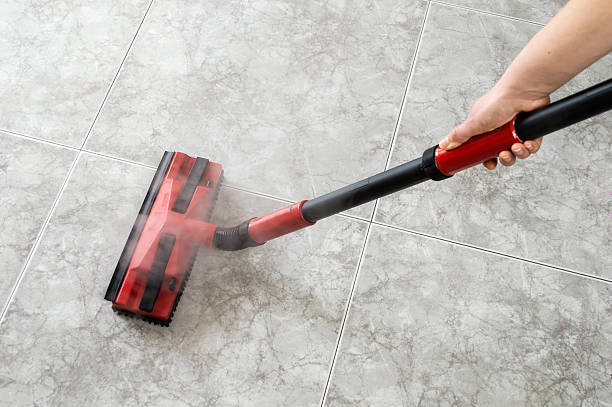Who does not like shiny ceramic and porcelain tiles in their house? If it has not been taken care of in time, cleaning tiles can be long and tedious.
Having ceramic floor tile can give your house the appearance it needs. Let us show you some of the best tips on how to clean ceramic tiles. Many people install ceramic tile floors in the kitchen, bathroom, or entrance. Ceramic tile looks gorgeous and is long-lasting. Despite being thoroughly cleaned they are often discolored. How do we maintain a spotless appearance? Tile scratches are a common problem that is not permanent. Regular cleaning removes dust particles that could damage the flooring.

Table of Contents
How to clean resilient tile floors
Resilient tile, which is made of materials like linoleum, vinyl, cork, and rubber, is a wonderful choice if you want a surface that’s comfortable for walking on and requires no upkeep. When cleaning your resilient tile floor, bear the following advice in mind:
Vinyl Tile floors
This incredibly durable flooring option is also simple to maintain. Simply sweep or vacuum away any dirt, and then mop the floor with vinegar and water or a vinyl cleaning solution. Never scrub vinyl with an abrasive cleaning or equipment as this could cause scratches.
Checkout here that how mop steamer makes floor cleaning easier
Linoleum floors
Despite being frequently confused with vinyl flooring, linoleum is a fundamentally different substance that requires special cleaning procedures. Wash the linoleum tiles with water, Borax detergent, or linoleum flooring cleaning solution after sweeping or vacuuming. Dry the floor after rinsing it well. Every three to six months, apply a coat of wax or liquid wax and buff it to a sheen to protect your linoleum floors.
Cork Tile floors
Depending on how your tiles are finished, different cleaning procedures are required for your cork tile. Clean the cork surface with water and a mild soap or white vinegar, and then thoroughly rinse if the polyurethane coating has been applied (most cork floors have this seal). Follow the cleaning recommendations for polyurethane if the cork is unfinished or waxed, but once the tile has dried, apply solid or liquid wax.
Cleaning ceramic and porcelain tiles

With a few simple cleaning techniques, ceramic and porcelain tiles can be kept looking spotless for a very long time. To clean ceramic and porcelain tile, just follow these easy steps:
1. Clean debris
Clear away any loose debris. To prevent dulling of your tile flooring, sweep or vacuum them frequently. Despite being dirt-resistant, sand and grit can degrade the glazed surfaces of ceramic tiles.
2. Choose your mop
Use a rag or chamois-style mop to clean tile rather than a sponge mop and clean water. Because sponge mops have a propensity to drive soiled water into the grout lines, making them more difficult to clean, these mops are perfect for cleaning tiled floor. While mopping, be sure to constantly replace the water because murky floors result from filthy water.
3. Be on the lookout for stains
Watch out for stains on the tile: If you see a stain, try to identify the material that caused it first. For the best cleaning results, choose the right cleaner for the stain.
4. Check for soap traces:
Even after washing, your tiles could still appear cloudy because of soap residue. Use a nonabrasive all-purpose cleanser to remove the film. On ceramic or porcelain tiles, you might also experiment with a DIY cleaner with a little acid, such as fresh lemon juice (but never on stone tiles).
5. Dry the tile floor
Do not let the standing water on your glazed tile flooring air dry as this may cause water stains. After washing, take care of that by quickly drying the floor with a clean, lint-free cloth.
Steam cleaning your floors
Over the past several years, steam cleaning has become the preferred method for cleaning and sanitizing a variety of things, including all kinds of vehicles along with homes, offices, medical facilities, and many different types of commercial businesses.
Steam cleaning is environmentally friendly as operators need little or no additional detergents or other agents to sanitize and deodorize many different surfaces. Steaming’s biggest advantage is its ability to kill and remove more than 99% of bacteria, viruses, germs, and other pathogens. However, working with a large diesel-powered seamer isn’t practical for many different types of cleaning jobs. Check out the new mobile steam cleaner Fortador Volt MINI.
How to clean tile grout

Clean grout is the actual key to a beautiful tile floor. Grout can be challenging to maintain clean because it is porous and absorbs stains like oil and other substances. Here’s how to restore the fresh appearance of your grout:
Make your own grout cleaning at home by mixing baking soda and water to create a paste.
Scrub grout: Apply it to the stain, let it sit overnight, and then scrub the stain with a firm nylon brush or an old toothbrush the next morning (a metal brush will damage the grout). Repetition is required.
Apply a silicone-based sealer to the grout to make it stain-resistant by sealing it. When done 10–14 days following grout installation or replacement, this works best.
How to clean your tile floor with a Fortador steam cleaner

You will find instructions on how to clean tile floors with a Fortador Volt Mini steamer. Depending on what steam mop you use, instructions and steps may vary.
1. Collect any loose dirt with a broom
To make sure you are not letting any dirt sticking to the floor, collecting the dust prior to a wet clean is crucial for a spotless tile floor.
2. Check what type of tile floors you have
There are varieties of floor tiles, including ceramic, quarry, cement, and natural stone.
Tiles made of porous natural stone, such as travertine, marble, and limestone, ought to have been sealed to assist prevent staining.
Others don’t need sealants since they can withstand moisture, such as ceramic and porcelain. Quarry tile is a bad choice for stove backsplashes because it can stain quickly if it is unglazed, but thanks to its earthy tones, it can readily hide the occasional spill on the kitchen floor or in the mudroom.
You’re prepared to proceed to the following phase once you’ve been comfortable with the type of tile you have.
3. Choose your cleaning solution based on your tile floors
In general, you shouldn’t clean cement tiles with anything acidic, including vinegar-based solutions; instead, use “safe for stone” cleaning products on marble, travertine, limestone, and other natural stone tiles while being careful to stay away from bleach-containing cleaners.
You can normally use vinegar-based cleaners to clean ceramic and porcelain tiles if you so want. However, before installing any type of tile, make sure to read the manufacturer’s instructions.
For cleaning advice particularly on stains, check with your tile manufacturer. Spills of pasta sauce could demand a different cleaning procedure and/or item then, for example, grease splatters.
For spills of common food and tracked-in dirt, warm water and a sponge work well. Warm water and a small amount of soap should be the following step after mere water and a sponge.
4. Turn on your steamer
Plug your Volt Mini into the outlet. Press the button on the touchscreen to turn it on. You should hear a beeping sound asking you for water. If you would like, you can attach a spray bottle provided in the attachment and add a cleaning solution inside. Wait for your steamer to heat up.
5. Attach any of the stiff brushes onto the steam nozzle and clean the tile grout

By doing so, the scrub brush is going to help you clean the grout lines with ease. Tile grout can get dirty over time, so make sure you steam it one by one, wiping off any excess dirt with a damp cloth.
After you are done cleaning the tile grout, you can move on to cleaning the tile flooring.
6. Attach the steam mop
After your grout tile grout have been cleaned, attach the steam mop to your steam nozzle. On the steam mop, attach a clean microfiber cloth. It will soak up all the leftover dirt from your tile floor.
No matter whether you have ceramic or porcelain tiles, start cleaning your floor like you would with any regular mop. If you have a spray bottle attached to the steam mop, the cleaning agent of your choice (floor cleaner or homemade solution) will help deodorize any smell even more.
7. Wipe the floor dry
If you need to, go over any spots or grout that have not come off with your steamer. After you have cleaned the grout and tile floor, wipe the floor with a clean cloth. To avoid any unwanted stains, make sure your floor is completely dry before anyone steps on it.
Checkout more such informative blogs by us here: Tokating Trading Agency

